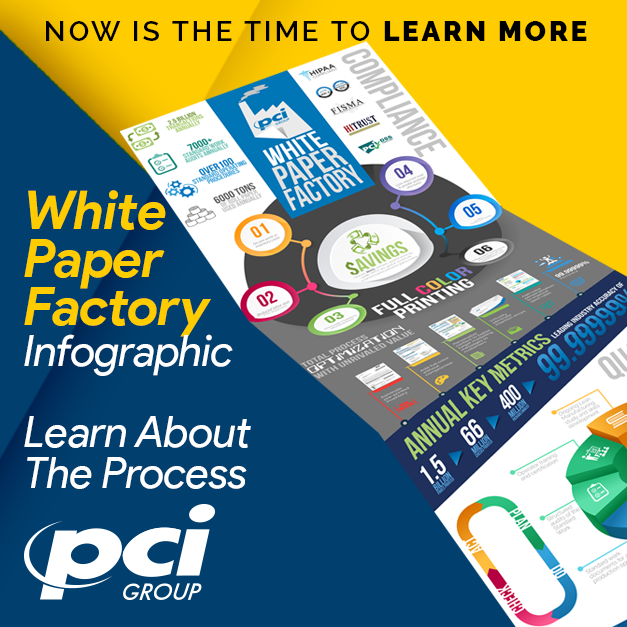
When quality and accuracy matter, companies turn to methodologies to improve on both these goals. As a transactional print and mail company, we are process-oriented, and each process must be consistent. Otherwise, we couldn’t deliver services that meet compliance regulations. We’ve adopted both Six Sigma printing and Lean printing principles. While they are similar, they aren’t the same. So, what’s the difference between Six Sigma vs. Lean?
Lean Printing and Six Sigma Printing Explained
First, let’s look at what each thing is. Lean Manufacturing is a systematic method that an organization uses to operate most efficiently. Its foundation is continuous process improvement. It leverages tactics to identify and drive out waste of materials, time, effort, and motion. Our Standard works are a significant part of Lean Printing, and they document how operators perform work, broken down into every specific task.
Six Sigma is a methodology that organizations use to remove waste from any process. It involves techniques and tools for process improvement.
Six Sigma vs. Lean: Similarities and Differences
Six Sigma is rooted in Lean, so that’s why many use them interchangeably. However, there are key distinctions between the two. Let’s look at how they are similar and different.
Defining Waste
Waste (and its elimination) are crucial points of both methodologies. They aren’t defined the same way, though. Lean defines waste as any process or task that doesn’t add value to the customer. Whereas in Six Sigma, it results from a process variation.
To eradicate waste, Lean focuses on an optimized process to deliver value. Six Sigma seeks to remove it by reducing variability. Both are critical in the transactional space.
Lean Printing Is a Mindset; Six Sigma Printing Is a Practice
Another angle on Six Sigma Printing vs. Lean is what they are. Lean printing is a mindset backed by a set of principles. When followed throughout the facility, it’s always in a state of continuous improvement. Lean is a cultural philosophy that everyone must adopt to drive efficiency.
Six Sigma printing is an actual program—a structured approach to solving organizational challenges by getting rid of variability and reducing risk. Six Sigma has a certification system with five distinct roles:
- Black Belt: Leads problem-solving projects and trains and coaches the project team.
- Green Belt: Assists with data collection and analysis for Black Belt projects.
- Master Black Belt: Trains and coaches Black Belts and Green Belts, develops metrics and strategic direction, and is the organization’s Six Sigma technologist and internal consultant.
- Yellow Belt: Participates as a project team member and reviews process improvements that support the project.
- White Belt: Works on local problem-solving teams for overall projects and understands basic Six Sigma concepts from an awareness perspective.
With these differences, they each provide value to an organization. Six Sigma is a hierarchical model with defined roles to work on complex problems. The approach is all about the data relating to why the issue arises or continues.
Lean is less rigid and encourages all employees to be problem-solvers no matter their title. Lean is about cultural change and focusing on behavioral change to rid the process of waste.
 The Role of Six Sigma Printing and Lean Printing in Transactional Print and Mail
The Role of Six Sigma Printing and Lean Printing in Transactional Print and Mail
So, why do these approaches to efficiency, accuracy, and quality matter in transactional print and mail? There is no room for error or waste in this business. Processes must be exact, or mistakes get made. Those mistakes are no small things when considering compliance regulations.
Our commitment to these approaches includes standard work documentation for every production operation. Every member of our Quality Team has achieved a Six Sigma Green Belt or higher. Other employees have earned these, as well. These efforts make our plant floors as optimized as possible.
Other ways Lean and Six Sigma improve everything we do:
- They both ensure accountability, which is critical in the business and provides every person on the team with awareness of expectations and goals.
- Lean and Six Sigma enable us to have an industry-leading 9999% accuracy. That comes from the concentration on waste removal, standard works, and continuous improvement.
- We use these methodologies together to drive quality and standardization, shifting to a prevention culture versus an inspection one. We continue to audit processes over and over.
PCI Group Leverages Lean and Six Sigma to Deliver Quality and Accuracy
Our dedication to these methodologies is what sets us apart in the industry. If quality and accuracy mean everything to you in print and mail, then we’re the partner for you. Contact us today to see why so many companies rely on us to manage their mission-critical print and mail communications.


